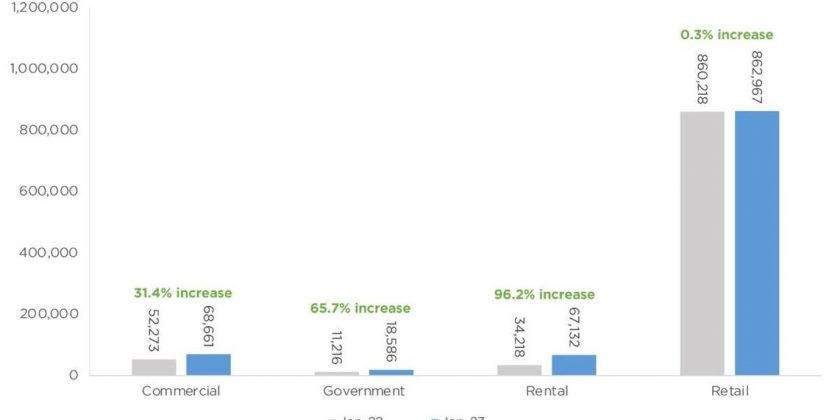Now at 16.5%, fleet market share is estimated to have gained 3.3% market share compared to last year’s share of 13.2%. That is a 2.3% share gain compared to last month’s 14.2% market share.
Graphic: Cox Automotive
Sales into large fleets, not including sales into dealer and manufacturer fleets, increased 58% year over year in January to 154,379 units, according to an early estimate from Cox Automotive released Feb. 6.
The large year-over-year gain was amplified by historic low fleet sales a year ago. Still, combined sales into large rental, commercial, and government fleets have seen seven consecutive months of double-digit, year-over-year increases. Sales into rental fleets were up 96% year over year, sales into commercial fleets were up 31%, and sales into government fleets were up 65%. Fleet sales were robust in January, juicing the total sales number.
Fleet Share of Retail Sales Increases Significantly in January
Including an estimate for fleet deliveries into dealer and manufacturer channels, the remaining retail sales were estimated to be up only 0.3% year over year, leading to an estimated retail seasonally adjusted annual rate (SAAR) of 13.2 million, down 0.2 million from last year’s pace, but up 1.7 million from last month’s pace. Now at 16.5%, fleet market share is estimated to have gained 3.3% market share compared to last year’s share of 13.2%. That is a 2.3% share gain compared to last month’s 14.2% market share.
Fleet: The Automakers’ Relief Valve
“To help keep retail supply limited and the seller’s market strong, we’ve been expecting automakers to become more aggressive with fleet sales,” said Charlie Chesbrough, senior economist at Cox Automotive, in a news release. “There are two main levers that can be pulled to support overall new-vehicle sales volumes in the face of declining retail demand: the fleet lever and the incentive lever. Looking at the January fleet sales estimates, it looks like at least some of the major manufacturers are choosing lever No. 1 and taking advantage of the fleet sales opportunity.”
In 2019, nearly 22% of all vehicles sold were through fleet channels. In 2022, the market shifted dramatically, with fleet closer to 16% in many months. With short supply, the automakers have focused on keeping retail channels stocked, but if there is consumer buying weakness in 2023, fleet sales could ramp up as there is likely still unmet rental and commercial demand.
Among the large manufacturers, Stellantis, followed by GM, had the largest increase in fleet volume compared to January 2022. Nissan and Kia had the largest declines from last year.
Source: Read Full Article

